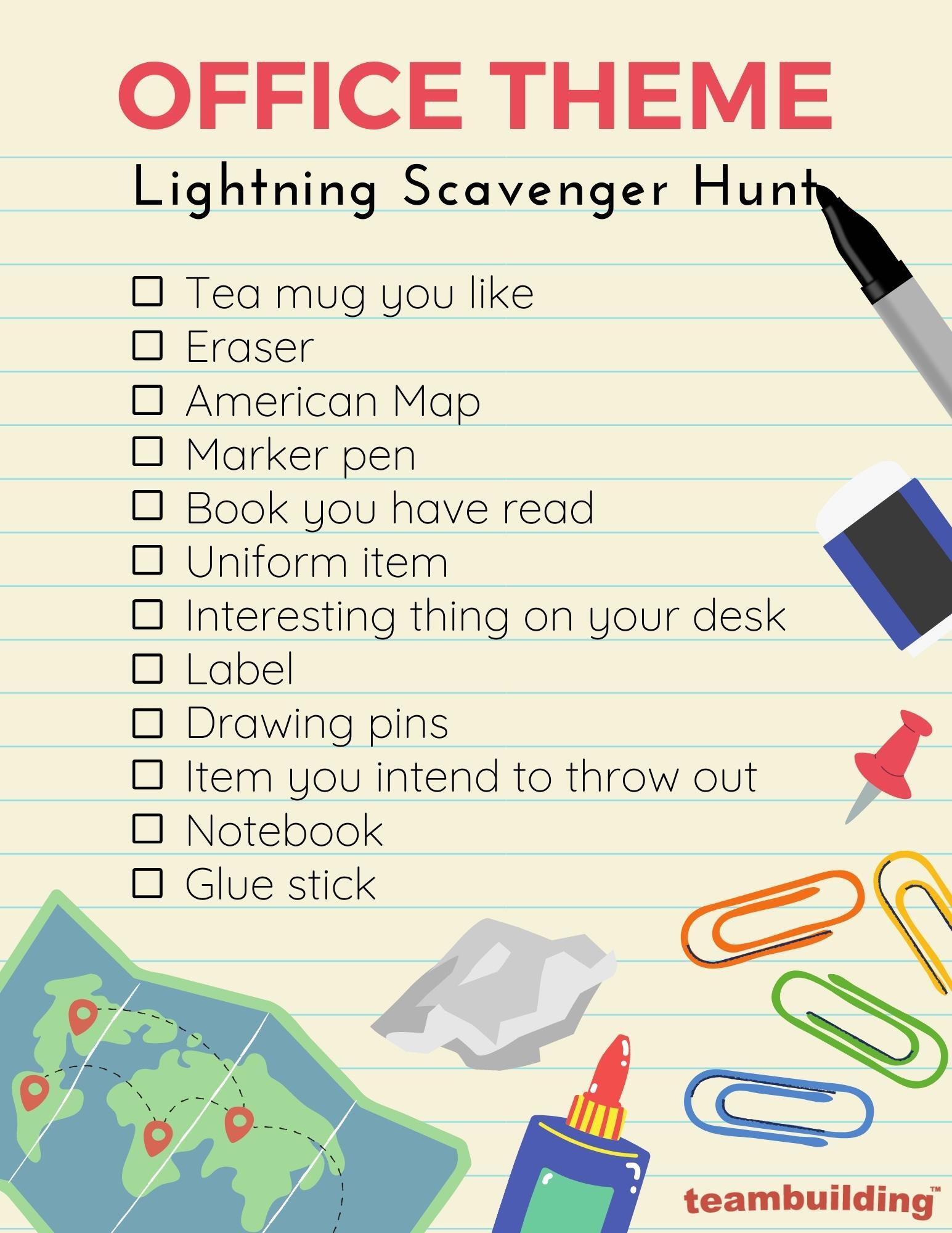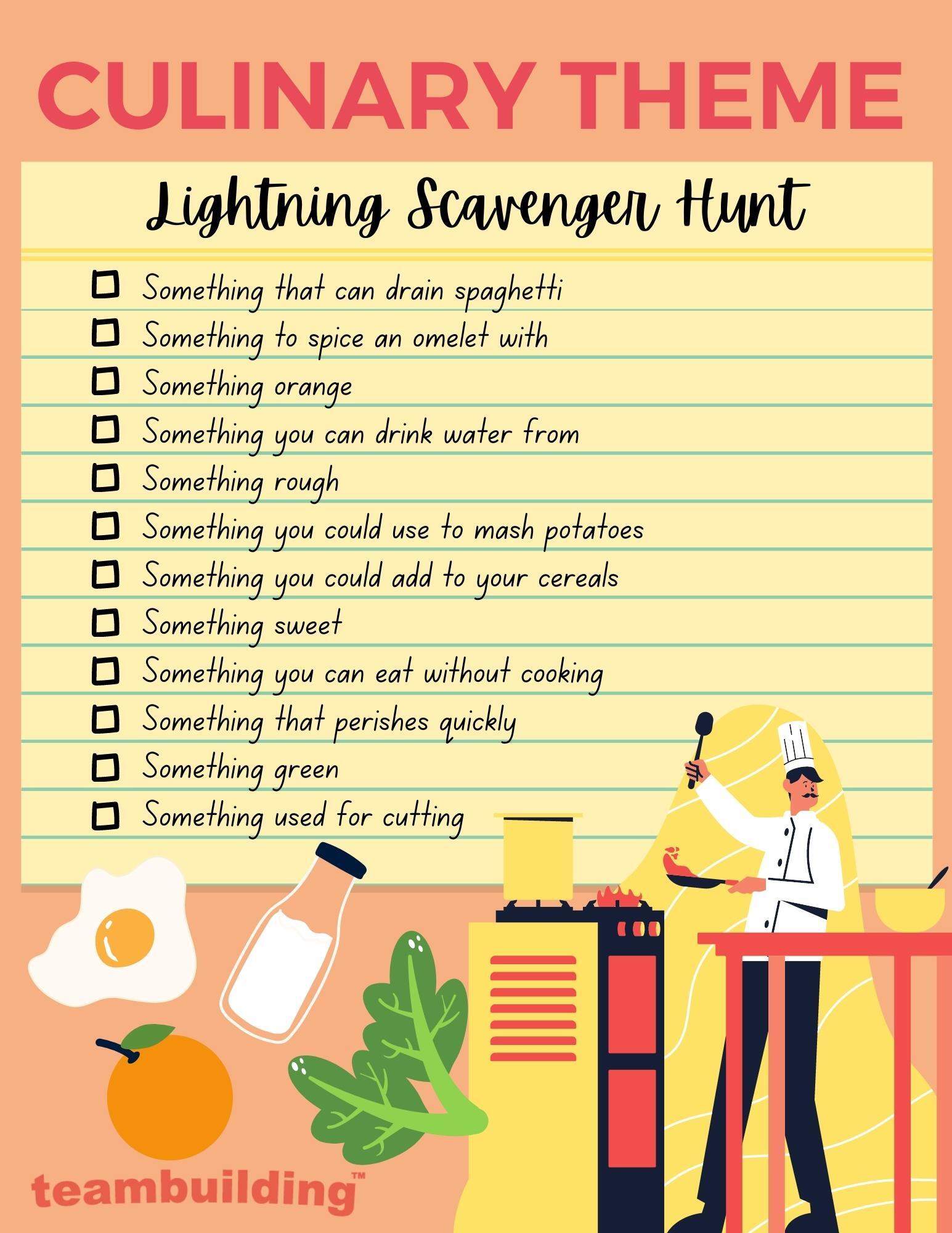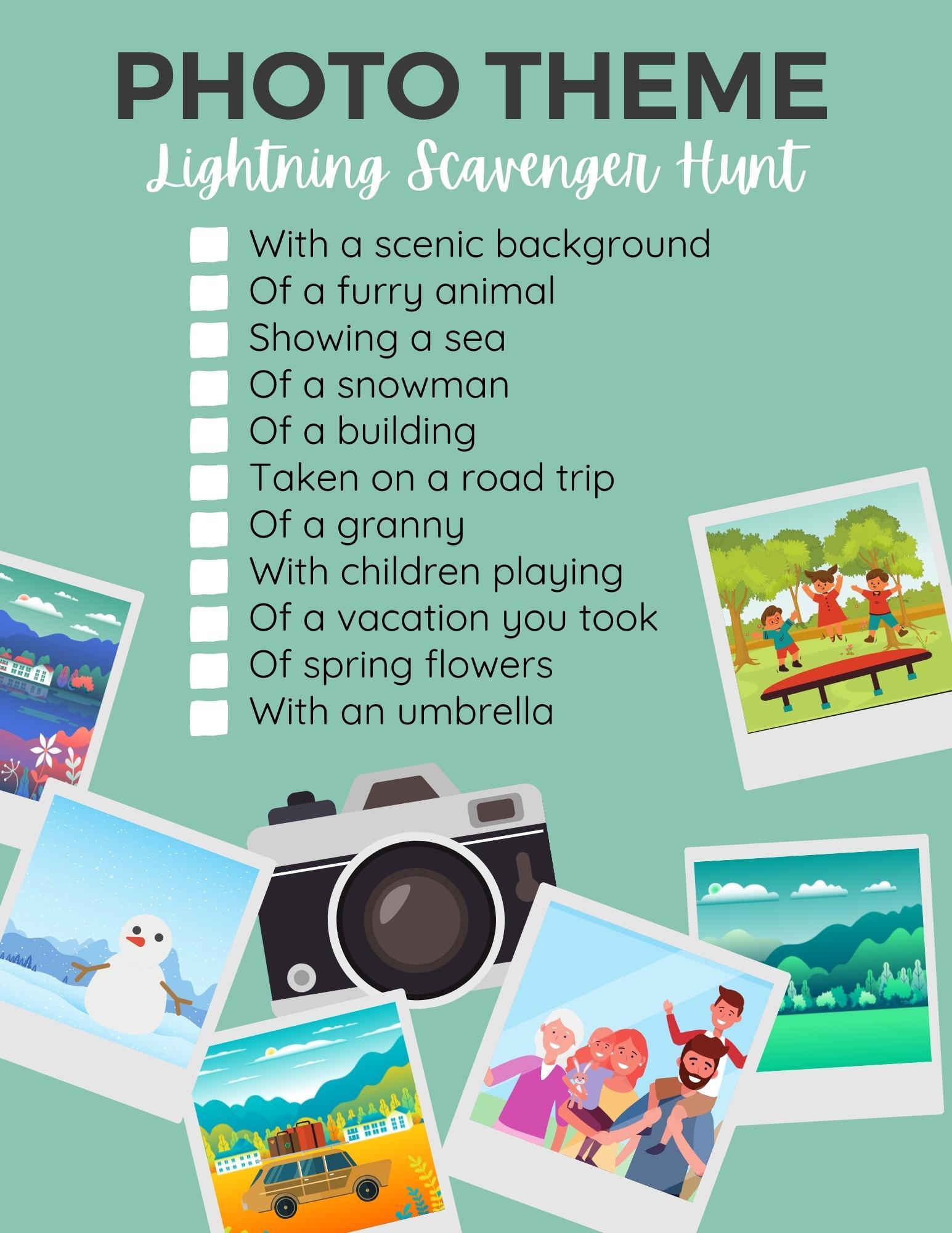You found our guide to lightning scavenger hunts.
Lightning scavenger hunts are games where a host asks for particular objects, and participants race to find and show the objects within a set time. The game revolves around a series of item or clue prompts, and players have to present the items one at a time. The first player to complete the puzzle and show the requested object wins the round. Lightning scavenger hunt games are suitable for in-person or virtual settings.
These exercises are subsets of scavenger hunts and examples of team building games and online team building games.
This article covers
- How to play lightning scavenger hunts
- Examples of lightning scavenger hunts
- Tips for lightning scavenger hunts
Let’s get started!
How to play lightning scavenger hunts
This section describes everything you need to know when preparing to play a lightning scavenger hunt. The information includes the games’ requirements, options, setup, and rules.
1. Player Age: Recommended for all age groups
This fun game fits all folks, young or old. Players may modify the game to suit the group’s characteristics. For instance, lightning scavenger hunt items for adult teams may be more challenging than that of teams in grade school. However, applying appropriate difficulty levels makes the hunt enjoyable.
2. Number of players: Minimum of Three
You should have at least three participants to play: the host and two competing players. The host gives prompts, and two players compete against each other.
For small teams, divide the participants into two groups.
For large teams, split participants into groups of about five players. It is okay to have several mini teams competing to ensure every player participates actively.
3. Time per card: Approx 15 to 25 minutes
Each scavenger list item on a card represents one round of the game. Therefore, it may take the participants 30 seconds to two minutes to locate each item.
The time required to complete the total of puzzles depends on the number of prompts on the card and the difficulty locating the items. Generally, the faster participants find the objects, the quicker the game moves.
4. Mode of playing: In-person or virtual
Players can either play on online platforms or in person at a predetermined venue.
For in-person scavenger hunts, the players meet at a chosen location. In this case, it is best to have a printed or written list of the items to hunt. The leaders may perform prior research of the venue to get ideas on the items to list and safety measures to consider.
Participants in different geographical locations can participate in this game virtually. Players enter a video conferencing platform such as the Gather app and Zoom to play. Teams may use a lightning scavenger hunt generator for themes or item prompts.
For inspiration, check this list of virtual scavenger hunt ideas.
5. Variations of the game: Object hunt and clue-based hunts
Lightning scavenger hunts come in two main variations.
The first variation is the object hunt. This form is straightforward and only involves finding and displaying items. Competitors earn points based on who shows the listed objects first. A group that finds the required objects moves on to seeking the next item on the list.
The second form is the clue-based hunt. This form involves multiple clues. Instead of mentioning the exact object required, the list directs players to the location of that object using a series of clues. The clues may be written on the list or include notes hidden on strategic positions.
6. Setting up a lightning scavenger hunt
Here are the simple steps to get you started:
Step 1: Choose the mode of play
Decide whether you want to form an in-person or a virtual game.
Step 2: Choose your theme
Select the appropriate theme for the scavenger hunt based on your team. For instance, you can go with seasons like winter, holidays such as Christmas, and events like sports playoffs.
Step 3: Schedule the game
Select the date, time, and location for the activity and communicate it to all participants. Be sure to share an invite link with the virtual players.
Step 4: Prepare the list
Based on the chosen themes and variations of the game, list the relevant items for players to seek. It is cheaper to use available items than to purchase those items.
Step 5: Set up the objects and clues
Be sure to hide the items so that participants have to hunt. For an interesting experience, mix easy and difficult challenges in locating those objects. Also, incorporate hints that lead to the next object’s location so that participants follow the order as closely as possible.
Note: This step is optional but suitable for in-person lightning scavenger hunts where players seek hidden objects.
Step 6: Let players begin the search
For virtual and simple clues scavenger hunts, the host mentions the item to find, and the players rush to search for the object.
The host issues teams with the multiple clues scavenger hunt list, and the team commences the search based on the list guide.
Remember to make requests or give out hints one at a time.
Step 7: Declare the winner
For simple clues, tally the wins for every round. The group with the most wins is the ultimate winner.
For multiple clues, the winner is the first person or group to find the final objects. However, the winner must have completed all the previous clues to win.
Step 8: Award the winner
The host awards the announced winner.
Tip: Before the game, the host may mention the predetermined prize. However, if you prefer surprises, you can add hints about the award alongside the game’s clues.
7. Scoring guide
A lightning scavenger hunt is a competition, and players should strive to win.
Below are scoring issues to clarify before the game begins:
- Point values per item
- Boundaries for the search
- The time limit for the game
- Order of completion, i.e., whether it is systematic or random
- Game rules, such as the list below
As a best practice, brief the players on how to earn points and the practices that may disqualify participants or deduct the points earned.
8. Game rules
Here are the basic rules for a lightning scavenger hunt game.
- The first player to show an item on the list earns a point for the round
- All objects should carry equal points
- Players must find the exact item in the list to qualify for a win. However, the judge may allow reasonable substitution. For instance, if the list requires flowers, the judge may allow players to present natural or artificial flowers.
- The first player to grab most of the items on the list is the ultimate winner.
- The host has the final say on the win.
- Players must find items only within the set boundary and within the time limit.
- Players must uphold the fair play principle. The host will disqualify participants who ruin the game, such as a player who hides another player’s clue.
- For groups, members of the same group must search the items together. Players will not be allowed to split to find separate list items at a go.
- If the host proposes a systematic order, then players must find the items in the order of the list without skipping an item.
Players may use the rules or modify them to suit the needs of different groups.
Examples of lightning scavenger hunts
Lightning scavenger hunts are highly customizable Here are examples and themes you and your team can try.
Standard lightning scavenger hunt
Here is a template a majority of the audience can play.
Find the following items within a 200m radius
- An item you rarely need
- Favorite snack
- Gift from a friend
- Something furry
- Music playing device
- A fruit
- A picture of you with an animal in it
- A flash drive
- An electronic device
- Something you could eat soup with
- A pair of scissors
- An old glove
You can use this template for the game. The template may also be useful for a mock game to test whether the participants understand the game rules.
Below are more examples for inspiration.
Office theme

Find the following office items within your premise
- Tea mug you like
- Eraser
- American Map
- Marker pen
- Book you have read
- Uniform item
- Interesting thing on your desk
- Label
- Drawing pins
- Item you intend to throw out
- Notebook
- Glue stick
This scavenger hunt is suitable for coworkers.
Culinary theme

Find these kitchen items
- Something that can drain spaghetti
- Something to spice an omelet with
- Something orange
- Something you can drink water from
- Something rough
- Something you could use to mash potatoes
- Something you could add to your cereals
- Something sweet
- Something you can eat without cooking
- Something that perishes quickly
- Something green
- Something used for cutting
This scavenger hunt is a suitable icebreaker for teams set for a cooking activity.
Kids theme
Find an item that:
- Contains the first letters of your names
- That ends with the last letter of a friend’s name
- Rhymes with book
- You can write on
- Is a round toy
- You color pictures with
- You made it without the help of your parents
- You can use it to measure
- You would love to give a friend
- Your teacher gave you
The word-theme list benefits players seeking to improve their vocabulary, such as students and adults learning a new language.
Outdoor theme
Take a picture of something that:
- Can cut grass
- Has a smooth surface
- Has two wheels
- Children like
- Is very tall
- Is beautiful
- Is abandoned
- Can be recycled
- Is bright-colored
- Is expensive
This hunt is suitable for teams on a walk, picnic, and other outdoor activities.
Check out more outdoor team building activities.
Easter theme
Here is a sample of clues for an Easter egg hunt. In this game, players look for written notes in the suggested locations. These notes bear the name or description of the item to search for.
Find the objects based on the following clues:
- If you have played this game before and you really want to score, then you know you can’t ignore a clue by the door.
- When you see a bunny hop, and it doesn’t seem to stop, it is time to pick the mop, and a clue might just drop.
- The day looks bright; the clues you want to find will guide you just right. Get yourself some sprite.
- A few more zig-zags, but there’s no time to lag. First, check your bags for a clue in the mags.
- Do not despair; we are almost there. Under that armchair, a clue awaits you there.
- Near your blanket, there’s a jacket; inside the pocket is a clue to the basket.
- That was super; you are such a shooter. So rest your legs and enjoy the eggs.
Players can play this option to usher in the Easter holiday.
Here are more Easter team building ideas.
Pet theme
Here is a template for a pet-themed scavenger hunt.
- Your pet’s favorite snack
- First pet toy
- Old pet collar
- Uncommon pet
- An item your pet ruined
- Funny pet picture
- Something your pet likes
- A dog leash
- Fur brush
- Pet water bowl
If you are an animal lover or pet owner, then you would love to play this theme.
Photo theme

Find a photo
- With a scenic background
- Of a furry animal
- Showing a sea
- Of a snowman
- Of a building
- Taken on a road trip
- Of a granny
- With children playing
- Of a vacation you took
- Of spring flowers
- With an umbrella
This list is suitable for employees who spend most of their work hours sitting or before a screen.
Here is a list of photo scavenger hunt ideas.
Indoor theme with rhyming clues
Rhymes are fun when used as clues. The rhymes may represent the items to look for or the location to find those items. These clues test accuracy in reading or listening, especially because the players are rushing to win.
We recommend leaving off the last word when reading out the clue, so that players must discern the location. Participants must either look in that spot, or be the first to shout out or type the word.
Here is an example that uses rhyming clues for leads.
- The fun just began; Now, show us your (pan.)
- Want to feed a partridge? Get some fruit from the (fridge.)
- Our shirts are stained with ink; Shall we wear something (pink?)
- I enjoy the scene by the window, could you bring your ugly (pillow?)
- Amazing how birds do sing; let us gather things that (ring.)
- By now, you must be in a rush. Take it easy and show a (brush.)
- You are doing well so far; where is your friend full of (fur?)
- Almost at the last clue, but where is that (screw?)
- This is a game I really love, but it may ask for a rugged (glove!)
- Are you still up for the win? Let us see your empty (bin.)
The indoor theme hunts are suitable for players familiar with the house and compound of the venue—for example, family and friends. The judge awards points for finding the right object.
Check out more on indoor team building.
Tips for lightning scavenger hunts
Lightning scavenger hunts are speedy games. Below are tips that will make you have the most fun with the challenge.
- If playing virtually, then ask the group to disconnect wired headphones. Instead, participants can use wireless headphones or computer speakers.
- When preparing the list, vary the game difficulty by incorporating a mix of common items and unusual objects.
- Include pictures, especially when working with younger school teams.
- Have at least ten search items per list
- When playing outdoors, use maps to mark boundaries for the search. Maps facilitate locating the objects and guide the players not to trespass into private properties.
- Take safety precautions when playing in an unfamiliar location.
- Consider the weather when planning an outdoor lightning scavenger hunt.
- Issue different clues to separate groups to avoid crowding in one area.
- Vary difficulty levels. For instance, make puzzles easy for kids and challenging for adults.
- When doing virtual hunts with clues, coordinate with a member who can help you set up. For instance, a teacher can coordinate with parents for students’ scavenger hunts.
- Have a prize for the winner. The prize should be an item or service that the group would enjoy The prize does not have to be expensive.
Conclusion
Scavenger hunts are a healthy physical and mental exercise for teams. The game is highly versatile. The players can modify the rules to suit all kinds of teams at work, home, or school. In addition, participants can try different themes, including movies, pets, and photo hunts.
A lightning scavenger hunt is quite simple to conduct, for it needs at least three participants, a list of clues, and the rules are simple Players can play the game indoors or outdoors and virtually or in person.
For more fun activities, check out Can You Hear Me Now, The Human Knot, and Zoom games for coworkers. To learn why playing games in meetings is important, read about the 8% rule.
We also have a list of the best scavenger hunt clues at the office and a list of treasure hunt ideas and examples.
